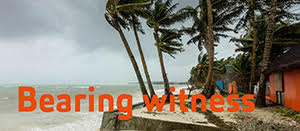Hele Ikimotu’s “life on Rabi” video reflections. Video: Pacific Media Centre
By Hele Ikimotu on Rabi Island, Fiji
Our trip to Rabi was a long journey, first starting with a bus ride from Suva, driving straight onto a ferry in Natovi and arriving in Nabouwalu. That trip alone was about seven to eight hours.
From there, my uncle, Aretana Kabure, picked us up and let us borrow the car to head into Savusavu. After exploring the area for a bit, we then caught another bus which drove onto Princess Moana in Natuvu – the final stop before Rabi.
 Arriving on Rabi for the first time was a monumental moment for me personally as I am from Rabi Island. My parents, Janet and Jone, managed to make it and came with us. My mother’s last time in Rabi Island was in 1995.
Arriving on Rabi for the first time was a monumental moment for me personally as I am from Rabi Island. My parents, Janet and Jone, managed to make it and came with us. My mother’s last time in Rabi Island was in 1995.
The island’s inhabitants are the Banabans, who were forcibly relocated to Rabi in 1945 due to the destruction of their island from phosphate mining. The people kept the four villages of Banaba and brought them with them to Rabi – Buakonikai, Tabwewa, Tabiang and Uma.
When we arrived in the evening, we were picked up by my uncle, my mum’s brother, whom she hadn’t seen since her last time in Rabi. Immediately upon arrival, his family fed us – we went to sleep with happy stomachs.
As the morning sun greeted us and after a dip in the sea metres away from the house we were staying in, we began our journey in exploring Rabi.
There are three main modes of transport in Rabi: walking, horse riding and driving a car. Walking is the main – having your own car is a rarity on the island. You can call a “taxi” which comes in the form of a pickup truck. As you pass people walking, they wave and smile.
Fish for breakfast, lunch and dinner
We visited many of my relatives and they all welcomed us with food. We had fish for breakfast, fish for lunch and fish for dinner. It is a staple dish in Rabi.
In between the visits, we interviewed people about the effects of sea level rise on the island and also heard personal testimonies about the move from Banaba to Rabi. You will hear and see this soon.
The island of Rabi is beautiful. The more we explored the island, the more we fell in love with it. In one part of the island, you will find kids fishing. In another, men are clearing the weeds outside their church, a young girl in a hammock is rocking a baby to sleep and people are swimming in the clear waters.
Rabi is a welcoming island. The trip may be long but it is worth it. If one plans to go, it is best they know someone and organise accommodation beforehand as there are no hotels. The island isn’t a tourist destination, which makes it that more special. It is simply a homely environment.
Hele Ikimotu and Blessen Tom are in Fiji as part of the Pacific Media Centre’s Bearing Witness 2018 climate change project. They are collaborating with the University of the South Pacific.









































